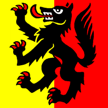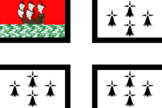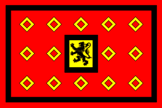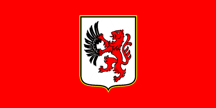- VEXIFERRET
- A colloquial term for one who undertakes an assiduous search for (sometimes obscure)
flag information (see also ‘vexiferreting’ below and
‘vexillologist’).
- VEXIFERRETING
- A colloquial term for the assiduous search for (sometimes obscure) flag information (see also
‘vexiferret’ above and ‘vexillologist’).
- VEXILLARIUS
- 1) See 'vexillifer'.
- 2) A member of a Roman military unit (vexillatio) detached from the main force under a vexillum –
but see ‘vexillation’ (also ‘vexillifer’ and
‘vexillum’).
- VEXILLARY
- 1) (adj) Of or pertaining to flags (see also ‘vexillology’).
- 2) See ‘vexillifer’.
- VEXILLATION
- Any detachment of soldiers serving under a vexillum - but see ‘vexillarius 2)’ (also
‘banderium’,
‘vexillifer’ and ‘vexillum’).
Please note this term is taken directly from the Latin vexillatio being a
detachment of soldiers as described above.
- VEXILLATOR
- A 19th Century term, now obsolete, for the standard bearer in a medieval mystery
play.
- VEXILLATRY (or VEXILLOLATRY)
- The treatment of a flag as a fetish or religious object.
- VEXILLIFER
- The bearer of the vexillum (see also ‘vexillarius 2)’,
‘vexillation’ and ‘vexillum’.
- VEXILLOBIBLIOPHILE
- A person who loves and/or collects flag books (but see also
‘vexillophile’ below).
- VEXILLOGRAPHER
- A designer of flags, or the creator of a flag design.
- VEXILLOGRAPHY
- The designing of flags, or the creation of a flag design.
- VEXILLOHOBBYIST
- A collector of flags and/or artefacts concerning flags – but see ‘vexillophile’.
- VEXILLOID
- 1) A rigid emblem (such as a carved animal or similar) mounted on a pole,
which fulfils the function of a flag but which is not a flag, and characteristic
(but not exclusively so) of traditional societies – not to be confused with a
tufa (see also ‘symbol 1)’, ‘tugh’ and
‘tufa’).
- 2) As above, but the forerunner of the flag as in the Nome standards of ancient
Egypt, the Semeia of classical Greece or in the Eagles of a Roman legion – a proto-flag (see
also ‘eagle 2)’,
‘Semeion’, ‘standard 5)’
and ‘symbol 1)’).
- 3) See ‘standard 6)’.
![[Nome Standard of Djeb]](../images/v/vxt-d1680.gif)
Nome Standard of Djeb, Ancient Egypt (philae.nu)
- VEXILLOPHILATELIST
- A student and/or collector of flag related postage stamps and/or of related
information.
- VEXILLOPHILE
- A collector of flags and/or of information regarding flags - a flag enthusiast
but see ‘vexillohobbyist’
(also ‘vexillobibliophile’).
- VEXILLOLOGIST
- A student of vexillology (see also ‘vexillology’).
- VEXILLOLOGY
- The scholarly or scientific study of the history, symbolism and/or usage of
flags.
Please note, the term was coined by Dr. Whitney
Smith of the Flag Research Center (Massachusetts, USA) and based on the Latin
vexillum (see also ‘vexillologist’ and
‘vexillum’).
- VEXILLONAIRE
- A person who is active in flag design or usage, or is engaged in promoting a specific agenda and/or
point of view with regard to flags.
- VEXILLOPHILY
- The collection of flags and/or of information regarding flags (see
‘vexillophile’ above).
- VEXILLUM
- An ancient Roman standard consisting of an often decorated (usually) red or purple
cloth hung from a cross bar. It is considered to be the first true flag in Western
culture, and from which the term vexillology is derived (see also
‘vexillarius’, ‘vexillifer’, 'vexillation' and
‘vexillology’).
![[Roman vexillum]](../images/v/vxt-d345.gif)
Vexillum of the 13th Legion (Eugene Ipavec)
Please note however, that whilst frequently described as a cavalry standard (which it was),
the vexillum also had a number of other military uses.
- VEXILLUM REGALE
- A medieval term, now obsolete, for the royal standard – see
‘royal standard 1)’.
Please note that it is unclear whether the medieval
chroniclers were referring to a banner of the royal arms as is common today, or
to a standard of the heraldic pattern known to have been used by many English
kings in the medieval period (see also ‘standard 4)’).
- VEXILLI ERECTIO
- A medieval term, now obsolete, for the fixing of banners or standards to the walls
of a fortress (see also ‘banner 1)’ and
'standard 4)).
- VILLENÉ
- See ‘priapic in its virility’.

Arms and Flag of Vauffelin, Switzerland (fotw)
- VIRILED
- See ‘priapic in its virility’.

Flag of Bern, Switzerland (fotw)
- VISUAL CENTRE (or CENTER)
- The term used when a charge is not set in the exact geometric centre of a flag, section of flag
or of the panel it occupies, or on a vertical or horizontal meridian of that flag, section or panel,
but is placed as to appear so centred to the observer – but see note below (also
‘centred’,
‘meridian’,
‘optical proportions’ and
‘panel’).



Civil Ensign of Japan 1870 – 1999 (CS); Flag of Manitoba, Canada (CS); Flag of Horní Radechová, Poland (fotw)
Please note that the examples given above show the pre-1999 merchant flag
of Japan with its disc set slightly towards the hoist, the arms on the flag of Manitoba placed a little
below the horizontal meridian and the flag of Horní Radechová with a charge set on the vertical meridian
but below the horizontal.
- VLAGGENSTOK WIMPEL
- See ‘wimpel 1)’ and ‘wimpel 2)’.

National Pennant/wimpel of Denmark
- VOIDED
- A basically heraldic term that is applicable to any ordinary (or other charge) when
the middle is removed so that the field of a shield or banner of arms may be seen through it
(see also ‘charge 2)’,
‘cross-voided’ in ‘appendix VIII’,
‘mascle’,
‘ordinary’ and ‘pierced 2)’).
![[voided examples]](../images/v/vxt-d615.gif)
Please note that in vexillology a voided cross such as shown above may, for example
(and with equal accuracy) be described as “a red cross, fimbriated yellow on a red field”
or similar.
- VOIDED CROSS
- See ‘cross-voided’ in ‘appendix VIII’.

Flag of Nantes, France (fotw)
- VOIDED LOZENGE
- The term for lozenge from which the centre has been removed thus leaving an outline only – an open lozenge or
lozenge-voided – see ‘lozenge’
(also ‘mascle’
and ‘voided’).



Flag of Bleiswijk, The Netherlands (fotw); Flag of
Morlanwelz, Belgium (fotw);
Flag of Landivisiau, France (fotw)
- VOIDED (or VOID) TRIANGLE
- The term for a triangle from which the centre has been removed leaving an outline only – a triangle
voided or void triangle (see also
‘voided lozenge’,
‘triangle’ and
‘voided’).



A flag of the Flemish National Union, Belgium (fotw); Low Visibility Roundel,
Austria (fotw);
Flag of the YMCA, Kosovo (fotw)
- VOL
- The French heraldic term for a pair of wings conjoined at the base and placed with the tips upwards,
but sometimes used when only a single wing is shown or differently orientated – but see ‘volant’ below
(also ‘conjoined 1)’,
plus ‘rising’ and ‘displayed’ in ‘appendix V’).


Arms and Flag of Šenkovec, Croatia (fotw)
- VOLANT
- The heraldic term for wings, and sometimes (but not invariably) used to signify that those wings are extended in a horizontal
position as if in flight – but see note below (also ‘vol’ above,
plus ‘rising’ and ‘displayed’ in ‘appendix V’).
![[volant example]](../images/v/vxt-d1124.gif)
![[volant example]](../images/v/vxt-d2143.gif)
Flag of Montsevlier, Switzerland (fotw); Flag of
Pfäfers, Switzerland (fotw)
Please note that these two terms (vol and volant)
can have a rather complex use, and we suggest that a suitable glossary or
dictionary of heraldry be consulted for further details.
![[Roman vexillum]](../images/v/vxt-d345.gif)














![[volant example]](../images/v/vxt-d1124.gif)
![[volant example]](../images/v/vxt-d2143.gif)

![[Nome Standard of Djeb]](../images/v/vxt-d1680.gif)

![[voided examples]](../images/v/vxt-d615.gif)